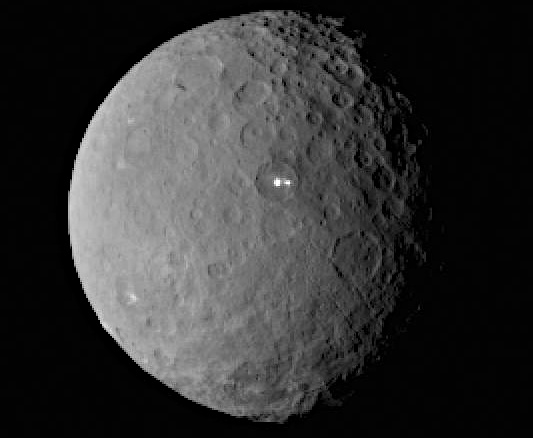
Image: This image of Ceres was taken by NASA's Dawn space probe on February 19, 2015, at a distance of 46,000 kilometers. The light spots show salt deposits at the bottom of the Occator crater, which is 92 kilometers in diameter. Photo credit: Public domain NASA.
Many small rocky bodies called asteroids are present in the solar system.
Asteroids are debris from the protoplanetary disk, which failed to come together to form a planet. A significant part of them circulate in the asteroid belt, between the orbit of Mars and that of Jupiter (between 2 and 4 AU). The asteroid belt thus marks the limit between the terrestrial planets and the gas giants.
If asteroids were "bright," we would see as many of them as stars in the night sky. An asteroid is a celestial object not observable with the naked eye, because of its small size which varies from a few tens of meters to several hundred kilometers in diameter.
The first asteroid was discovered by chance on December 31, 1800 by Giuseppe Piazzi (1746-1826), director of the Palermo observatory (Sicily).
It was while observing the constellation Taurus that he saw an unidentified object moving very slowly in the night sky. Carl Friedrich Gauss (1777-1855) determined the distance of this unknown object and placed this star between the planets Mars and Jupiter. Piazzi named it Ceres (goddess of agriculture, harvest and fertility). Between 1802 and 1807, three other bodies were discovered: Pallas, Juno and Vesta.
In 1868, 100 asteroids were recorded. The 1,000th asteroid was approved in 1921 and the 10,000th in 1989. As of March 2006, there were 129,436 certified asteroids. According to the Minor Planet Center, in 2023, there will be 822,135 approved asteroids. This number is constantly changing, new asteroids are discovered every year.
Asteroids are classified based on their chemical composition.
The most common classification is that of Tholen based on observations of asteroids in the visible light domain. David J. Tholen, American astronomer (1955-) divided asteroids into 14 classes, but the three most common classes are C, S and M.
- C-type asteroids have a spectrum dominated by carbon absorption bands. They are the most numerous asteroids and are mainly composed of carbon. They are dark in color and have a very low albedo (less than 0.05).
- S-type asteroids have a spectrum dominated by silicate absorption bands. These asteroids, a little less numerous, are mainly composed of silicate rocks. They are light in color and have a medium albedo (0.05 to 0.15).
- M-type asteroids have a spectrum dominated by iron absorption bands. These asteroids are made of metal. They are metallic in color and have a high albedo (greater than 0.15).
These classes represent approximately 90% of all main belt asteroids.
Observations in other wavelengths, such as infrared, have made it possible to distinguish new classes of asteroids.